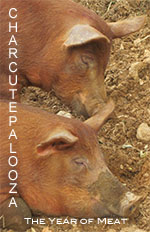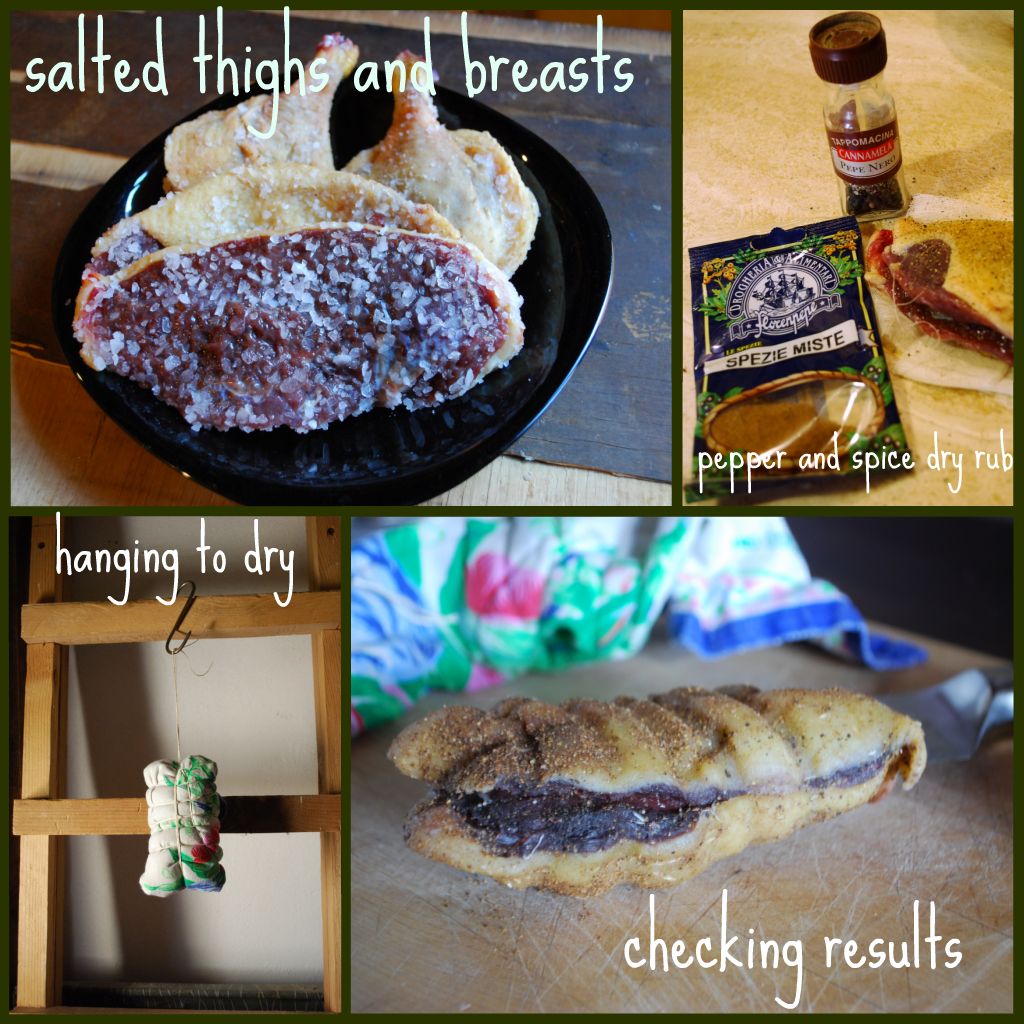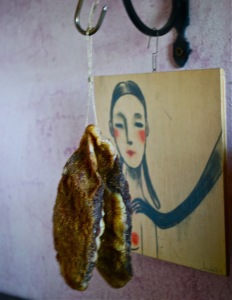 It is quite appropriate that the Charcutepalooza begins now.January 17th is Sant’Antonio D’Abate, patron saint of barnyard animals and the day, traditionally, that the pigs are slaughtered to become prosciutto, pancetta, guanciale and salami.
It is quite appropriate that the Charcutepalooza begins now.January 17th is Sant’Antonio D’Abate, patron saint of barnyard animals and the day, traditionally, that the pigs are slaughtered to become prosciutto, pancetta, guanciale and salami.
The weather is cold and damp and in stone farmhouses, perfect for aging meats with no special rooms or treatments, for centuries, families have fed themselves using recipes and traditional techniques passed on by previous generations.
Here in Tuscany, I usually attend the blessing of the animals at a local village, some towns have huge bonfires instead. Italians love to celebrate and where there is a celebration, there is food!
My favorite dish at the blessing of the animals is the pig’s blood crepe, Roventino, which can be had savory or sweet, topped with grated parmesan cheese or with sugar and lemon zest. I usually have both!
 Charcutepalooza is a year in meat, with a once a month challenge. It is the brainchild of Mrs Wheelbarrow’s Kitchen and The Yummy Mummy.
Charcutepalooza is a year in meat, with a once a month challenge. It is the brainchild of Mrs Wheelbarrow’s Kitchen and The Yummy Mummy.
Get your self a copy of Ruhlman’s Charcuterie and join in when you feel like it. They have coined the Ruhls for participating and there are over 100 food-bloggers on the Meat Bandwagon.
Way back in 2006, Kate and I already shared our Pork Love with IACP, bringing Fergus Henderson to talk with us about our love of Nose to Tail, butchers and traditional preserving techniques in Europe. We began a blog, to share our love of all thing pork- Savoring the Whole Hog.
Although I worked with Master butcher Dario Cecchini for 2 years, I really have no need to make my own charcuterie living in Tuscany, as I am surrounded by artisan butchers everywhere. But this challenge sounded like a lot of fun to join in and present the Italian way, some old world wisdom.
Here is a little progress report on my “duck breast prosciutto”. In northern Italy, where they do eat more duck, they make prosciutto from the thighs of both duck or goose. These recipes were mostly from the Jewish Italian cuisine where pork was not allowed. As in French cooking, especially in Gascony where Kate makes her home, ducks are like pigs, where every part is used.
I would really adore one of these “holders” for duck or goose prosciutto’s, am going to look for one at the Valsana website, where this foto is from.
Today was the day to check our “prosciutto” but as this has really taken off, there were some people, like myself, that started a little late and the final day to post will be the 30th. I will also do an update there on the final results.
 I salted the thighs and breasts, left overnight, rinsed and did dry rub with salt and Tuscan spice mixture. Wrapped and hung in cool place for a week. I salted the thighs and breasts, left overnight, rinsed and did dry rub with salt and Tuscan spice mixture. Wrapped and hung in cool place for a week. |
I unwrapped my duck breasts today, but found that I had been over zealous in the wrapping and that they had only lost 10% of the weight instead of the 25% which is considered perfect. As you can see in the foto, they are still red in most part.
 some dark dried parts, but mostly still damp
some dark dried parts, but mostly still damp
I decided to follow my heart and the more traditional Tuscan way of aging meats and repeated the dry rub of pepper and Tuscan spices and threaded the breasts with cotton cord and rehung in the cool space under the attic stairs.
 finishing the drying process, like a Tuscan would
finishing the drying process, like a Tuscan would
I will have better control over them that way.
Meanwhile, the February challenge has been posted. There are several choices, but it is all about salt curing. Bacon, pancetta or guanciale in the pork family, gravlax for fish, Moroccan preserved lemons? I love them all! It is all about the salt- and having been to the ancient salt flats in Trapani Sicily I am in love with my sea salt.
 this is where I get my salt, do you know where yours comes from?
this is where I get my salt, do you know where yours comes from?
Am contacting my friend and local pig farmer Ray at Casamonti in Castellina in Chainti, to see about getting some Cinta Senese Pork cheeks to make my own guanciale. This weekend I am heading to Rome to take part in a Pizza workshop at Tricolori Monti with Gabriele BONCI, Rome’s poster boy of all things made with flour, and have already arranged to go guanciale shopping with my Rome Guru, Elizabeth Minchelli.
I think in February I will have a lot curing in my pantry while I am in San Francisco teaching some classes, eating some good food and hanging with family and friends.


Looks beautiful, regardless, and so rustic hanging there “Tuscan-style”! 🙂 I also loved your reference to Saint Antonio d’Abata – great tie in and blog writing!
Looking forward to seeing your February post already!
Best,
Sarah
I was wondering about the cheesecloth and how necessary it really was. So enjoyed the Italian perspective! Thank you for being part of the meat-party.
@MrsWheelbarrow, our homes in tuscany are much cooler being made of stone. My neighbors have a guest room in the house dedicated to aging their prosciutto’s. Will post foto later in the blog!
@sara join us!
Beautiful Pictures. Look forward to the update when your duck finishes drying. The picture of the salt just floored me! How amazing.
What an informative post. I too was wondering about the cheesecloth. My husband suggested it might be to wick moisture away, but I didn’t see that happening on my duck breast.
yes– am sure the cloth is to absorb any moisture,as it loses another 30% while “drying”.
Although here in Tuscany– none is used- we also live in stone homes.
Next up will post the “bedroom” my neighbor uses for his prosciutto!